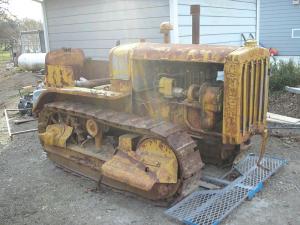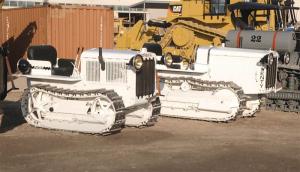2021 - Volume #45, Issue #4, Page #40
[ Sample Stories From This Issue | List of All Stories In This Issue | Print this story
| Read this issue]
Caterpillar Collector Hit The Jackpot
 |
 |
“When I got home with the tractor, I confirmed in the archives that it was what I thought it was,” says Veerkamp.
What made this 4-cylinder, gas tractor special was that it was the first new tractor design from Caterpillar. In 1925 C.L. Best Gas Traction Company and Holt Manufacturing Company consolidated under the new Caterpillar name. The experimental 20 made its debut a year later at fairs, trade shows and other expositions.
“Ag was the biggest market at the time,” says Veerkamp. “The 20 was designed for use in the groves and orchards to get into tighter areas. It was used for everything and had winches and pumps hung on it. It even had military applications.”
Eventually the 20 ended up at a ranch owned by a descendent of C.L. Best. Along the way, the once white tractor was painted Caterpillar yellow, its history forgotten. It became simply one of the 8,568 Caterpillar 20s built in San Leandro, Calif. and Peoria, Ill. from 1927 to 1931.
As Veerkamp and his father Doug began restoring the tractor, they faced several challenges. One was that as an experimental model, good specifications did not exist. Plus, although it looked like other Caterpillar 20s in the Veerkamp collection, there were differences.
“A lot of internal parts in the experimental 20 were one-off prototypes,” says Veerkamp. “They were more primitive than what went into the production 20s.”
It was during restoration that Veerkamp discovered the novel white color. Caterpillar colors originally were gray and red. Caterpillar yellow had not yet been adopted. They also found nickel and brass plating used to dress it up.
Hard use over the decades since it was a showpiece had also taken its toll. “The axles, transmission and clutch were worn out and had to be fabricated,” says Veekamp. “Restoring the engine was fairly easy. We were testing it before we finished the rest of the tractor.”
Restoration took 4 mos. The tractor was taken apart completely, down to every nut and bolt. The father and son team restored or rebuilt virtually every part. Today it runs like new.
The Veerkamps have other experimental and unique tractors in their collection. These include the experimental prototype of the 1929 Caterpillar 15. Finding them is what VeerKamp refers to as the hunt. He has been hunting since he was 15, adding to the collection his father started a dozen years or so earlier.
“You need to look for the slight variations,” says Veerkamp. “You also need to learn the story, where the tractor worked and who owned it. Finding the story adds value.”
Contact: FARM SHOW Followup, Matt Veerkamp, Doug Veerkamp General Engineering, 2585 Cold Springs Rd. Placerville Calif. 95667 (ph 530 676-0825; matt.veerkamp@dougveerkamp.com).

Click here to download page story appeared in.

Click here to read entire issue




